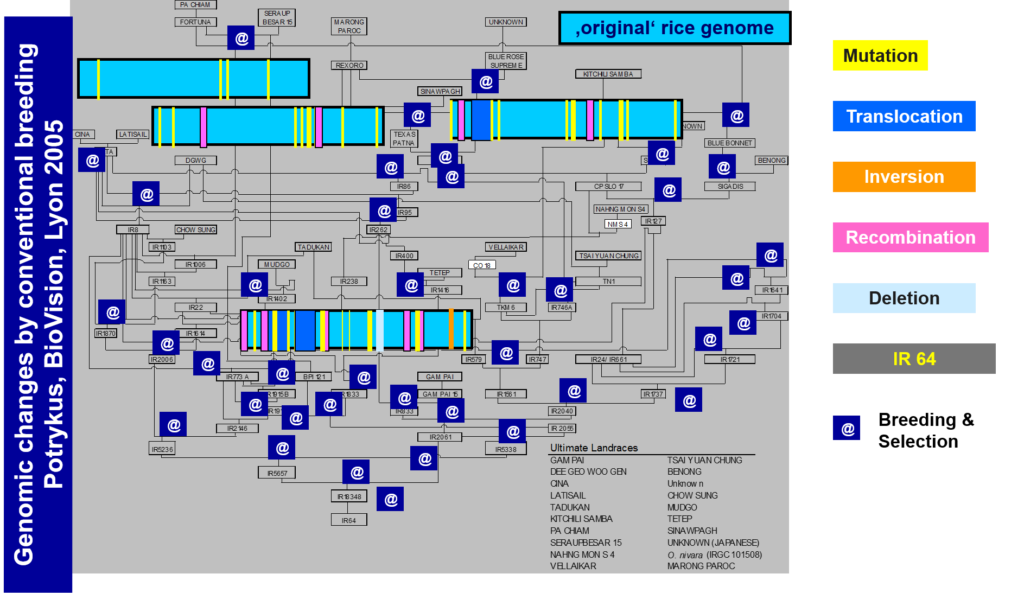Mutants are usually not as spectacular as Spiderman or the Hulk. They are much more ordinary.
Every human has about 30 to 60 new mutations, most of which are not even noticed. However, many mutations are lethal. In humans, it is believed that 50% of fertilized eggs or very early embryos are spontaneously aborted because they are not viable. This is mostly not even noticed by the mother.
In plants, mutations are not much different: many are lethal, some are unnoticeable, very few have an advantage. In the grains of a wheat field of one hectare, statistically speaking, every position in the genome is mutated once – and the wheat genome is very large!
Unless there is natural or artificial selection, these mutations don’t matter much. But they are there and we eat mutants all the time!

But the likelihood for a mutant killer-pumpkin with four eyes, and zombie wheat is very low!
What can happen during breeding and crossing?
When you breed and select for certain properties, you can carry over other traits unnoticed. For example, one selects for large, juicy fruits and only realizes much later that with the selection the defense against aphids has decreased. This is because genes that are close together are usually inherited as “one package.” If you throw out the undesirable gene for small, dry fruits and right next to it is the one for aphid resistance, you will very easily throw out both at the same time when you select for large juicy fruits! That the fruits are better, one can see immediately, that the natural resistance is gone, one notices only when the aphids come!
What is natural?
None of our plants in agriculture are “natural”: a seedless melon or grape would not stand a chance in the “wild”: it cannot reproduce by seed.
But for us they are useful: tomatoes with less solanine are less toxic than their natural ancestors and therefore safely edible – unfortunately also for beetles and caterpillars! A 3kg melon has significantly more nutrients than its ancestor with 30mm diameter. And who would like to eat a natural banana that consists of 50% hard seeds?
Where do mutations come from?
Mutations occur everywhere and at all times. Roughly speaking, we can distinguish three different sources of mutations:
1. faulty duplication of DNA. Most copying enzymes (DNA polymerases) work quite accurately. In addition, proofreading by enzymes detects and corrects errors. Nevertheless, errors still occur. Correctly transcribing the human genome of 3 billion “letters” (base pairs) is a daunting challenge. A human being consists of about 30 trillion cells and for each cell the genome has to be copied. It is rather surprising that there are not much more errors (mutations)!
2. environmental influences. Our environment is dangerous! Solar radiation causes mutations as well as radioactive radiation (which also occurs naturally). In addition, all living beings are constantly exposed to cell poisons, which have their origin in plants and animals. Cell poisons in the form of environmental pollution, which we “invented” ourselves, are added to this. Many of them trigger mutations. 3. gene transfer between different organisms. This is rare – but scientists find more and more of it! Bacteria and viruses can transfer parts of their genome into plants and animals, plants and fungi can exchange genes when in close contact, and much more. This “horizontal gene transfer” is a special kind of mutation in which genes from foreign species are pushed from one genome into the other.
Can we find mutations in a genome?
Yes, we can – but in most cases only, when we analyze the complete DNA of an organism.
That everything is full of mutations was shown in 2005, after the complete sequencing of the rice genome and comparison with agricultural variants.
The picture shows the lengthy, laborious crosses leading to one of the most successful rice varieties called IR 64. The @ signs mark each cross. The light blue background of the colored blocks shows the “original” rice genome. Note, however, that this is already a domesticated variety that was selected more than 8,000 years ago and has been subject to breeding selection ever since.
The colored markers on the light blue background indicate mutations found at four points in the breeding process:
yellow are minor mutations of a few base pairs, they can change genes or their regulation,
dark blue are translocations, i.e. larger rearrangements within the genome, several genes can be interrupted or placed under a new regulation, they can disrupt cell division,
orange are inversions, which are rearrangements within a chromosome, they can interrupt genes or change gene regulation,
purple are recombinations, i.e. exchanges (mostly) with the second chromosome. This can change genes or their regulation.
white-blue are deletions. Here, parts of a chromosome have been completely lost. In this case, genes or regulatory regions disappear completely or partially.

How do you do selective breeding and what can happen?
Viable mutations are not very frequent and a desired mutation is very rare. Therefore, in the breeding process, the number of mutations was enormously increased by radioactive irradiation or by the use of cell poisons (mutagens). This was completely untargeted. It is roughly comparable to treating 1000 wrist watches with a hammer and then checking if one of them is more accurate. This seems very improbable – but it works. Most of the watches (plants) are broken, but one or two have a new, desired property.
Many genes are changed by the hammer blows (mutagenesis). The vast majority have nothing to do with the trait you wanted, you don’t even know about them (because you don’t look for them). And you have no idea what hidden effects they have, let alone what effects the combination of all these mutations may have. They are unnoticed “collateral damage” carried along in the long crossing process and discovered much later.
Now this does not make IR 64 rice an unpredictable time bomb. It has been cultivated for many years and experience from these years shows that it does not cause any obvious damage – on the contrary, it has high yield and provides food. However, one can never rule out negative effects.
It is remarkable that these genetic changes are generally declared “natural and harmless”, even though they are not known at all.
However, as soon as similar genetic modifications are carried out by genetic engineering in a quite targeted manner people speak of “irresponsible genetic engineering” and “completely incalculable risks”. And: gene technology is often supposed to be dangerous because plants are “irreversibley released into the environment”. Well, so are “natural” mutations.
A natural random mutation that probably endangers an entire ecosystem occurred only a few years ago in a German aquarium – we will discuss this in one of our next blog articles.
Author: Wolfgang Nellen (w.nellen@biowisskomm.de
Translated with www.DeepL.com/Translator (free version – modified by the author)

